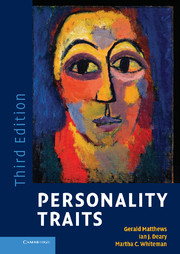77 results
Investigation of a K-Bentonite by X-Ray Powder Diffraction and Analytical Transmission Electron Microscopy
-
- Journal:
- Clays and Clay Minerals / Volume 36 / Issue 1 / February 1988
- Published online by Cambridge University Press:
- 02 April 2024, pp. 83-93
-
- Article
- Export citation
GWAS of Dizygotic Twinning in an Enlarged Australian Sample of Mothers of DZ Twins
-
- Journal:
- Twin Research and Human Genetics / Volume 26 / Issue 6 / December 2023
- Published online by Cambridge University Press:
- 23 November 2023, pp. 327-338
-
- Article
-
- You have access
- Open access
- HTML
- Export citation
The effect of vitamin D supplementation on pain: an analysis of data from the D-Health randomised controlled trial
-
- Journal:
- British Journal of Nutrition / Volume 130 / Issue 4 / 28 August 2023
- Published online by Cambridge University Press:
- 25 November 2022, pp. 633-640
- Print publication:
- 28 August 2023
-
- Article
-
- You have access
- Open access
- HTML
- Export citation
In-Hospital Delays for Acute Stroke Treatment Delivery During the COVID-19 Pandemic
-
- Journal:
- Canadian Journal of Neurological Sciences / Volume 48 / Issue 1 / January 2021
- Published online by Cambridge University Press:
- 03 August 2020, pp. 59-65
-
- Article
-
- You have access
- Open access
- HTML
- Export citation
A single day of mixed-macronutrient overfeeding does not elicit compensatory appetite or energy intake responses but exaggerates postprandial lipaemia during the next day in healthy young men
-
- Journal:
- British Journal of Nutrition / Volume 121 / Issue 8 / 28 April 2019
- Published online by Cambridge University Press:
- 30 January 2019, pp. 945-954
- Print publication:
- 28 April 2019
-
- Article
-
- You have access
- HTML
- Export citation
Authigenic chlorites: problems with chemical analysis and structural formula calculations
-
- Journal:
- Clay Minerals / Volume 19 / Issue 3 / June 1984
- Published online by Cambridge University Press:
- 09 July 2018, pp. 471-481
-
- Article
- Export citation
Analytical transmission electron microscopy in the study of diagenetic clay minerals
-
- Journal:
- Mineralogical Magazine / Volume 51 / Issue 359 / March 1987
- Published online by Cambridge University Press:
- 05 July 2018, pp. 123-124
-
- Article
- Export citation
Compositional variation within some sedimentary chlorites and some comments on their origin
-
- Journal:
- Mineralogical Magazine / Volume 49 / Issue 352 / June 1985
- Published online by Cambridge University Press:
- 05 July 2018, pp. 375-386
-
- Article
- Export citation
Effect of vitamin D supplementation on selected inflammatory biomarkers in older adults: a secondary analysis of data from a randomised, placebo-controlled trial
-
- Journal:
- British Journal of Nutrition / Volume 114 / Issue 5 / 14 September 2015
- Published online by Cambridge University Press:
- 24 July 2015, pp. 693-699
- Print publication:
- 14 September 2015
-
- Article
-
- You have access
- HTML
- Export citation
A comparative analyses of microstructures from Late Jurassic diamictic units, near Helmsdale, northeast Scotland and a Pleistocene diamicton from near Milton, southern Ontario, Canada – a differential diagnostic method of sediment typing using micromorphology
-
- Journal:
- Netherlands Journal of Geosciences / Volume 88 / Issue 1 / March 2009
- Published online by Cambridge University Press:
- 24 March 2014, pp. 75-94
-
- Article
-
- You have access
- Export citation
Contributors
-
-
- Book:
- Constructing the Self in a Digital World
- Published online:
- 05 October 2012
- Print publication:
- 10 September 2012, pp ix-x
-
- Chapter
- Export citation
The Queensland Study of Melanoma: Environmental and Genetic Associations (Q-MEGA); Study Design, Baseline Characteristics, and Repeatability of Phenotype and Sun Exposure Measures
-
- Journal:
- Twin Research and Human Genetics / Volume 11 / Issue 2 / 01 April 2008
- Published online by Cambridge University Press:
- 21 February 2012, pp. 183-196
-
- Article
-
- You have access
- Export citation
List of tables
-
- Book:
- Personality Traits
- Published online:
- 05 June 2012
- Print publication:
- 29 October 2009, pp xviii-xxiii
-
- Chapter
- Export citation

Personality Traits
-
- Published online:
- 05 June 2012
- Print publication:
- 29 October 2009
7 - The psychobiology of traits
-
- Book:
- Personality Traits
- Published online:
- 05 June 2012
- Print publication:
- 29 October 2009, pp 187-230
-
- Chapter
- Export citation
8 - The social psychology of traits
-
- Book:
- Personality Traits
- Published online:
- 05 June 2012
- Print publication:
- 29 October 2009, pp 231-266
-
- Chapter
- Export citation
1 - The trait concept and personality theory
-
- Book:
- Personality Traits
- Published online:
- 05 June 2012
- Print publication:
- 29 October 2009, pp 3-41
-
- Chapter
- Export citation
Part III - Consequences and applications
-
- Book:
- Personality Traits
- Published online:
- 05 June 2012
- Print publication:
- 29 October 2009, pp 267-268
-
- Chapter
- Export citation
List of figures
-
- Book:
- Personality Traits
- Published online:
- 05 June 2012
- Print publication:
- 29 October 2009, pp xi-xvii
-
- Chapter
- Export citation
3 - Personality across the life span
-
- Book:
- Personality Traits
- Published online:
- 05 June 2012
- Print publication:
- 29 October 2009, pp 63-84
-
- Chapter
- Export citation



